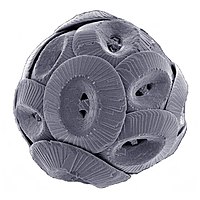
Photo from wikipedia
Microbially induced carbonate precipitation (MICP) by using ureolytic bacteria is a novel and environmentally friendly way to treat the un-cemented sand. It was implemented successfully in number of geotechnical applications.… Click to show full abstract
Microbially induced carbonate precipitation (MICP) by using ureolytic bacteria is a novel and environmentally friendly way to treat the un-cemented sand. It was implemented successfully in number of geotechnical applications. Use of organic additives to improve the MICP process is a novel and interesting approach. In this research, effect of the cationic biopolymer poly-l-lysine on the MICP process was investigated by using ureolytic bacteria Pararhodobacter sp. Urea hydrolysis by the bacteria in the presence of CaCl2 was conducted with the addition of the polymer under different conditions. Morphology of the precipitate of CaCO3 after oven dried was analyzed by using the scanning electron microscope. Bell-shaped curve was obtained for the variation between the amount of the precipitate with the increase of the amount of the poly-l-lysine. Poly-Llysine gives higher amount of precipitate than conventional MICP process and morphology of the crystals changed drastically from well-developed rhombohedral crystals to ellipsoidal shaped aggregates.
Journal Title: International Journal of Geomate
Year Published: 2018
Link to full text (if available)
Share on Social Media: Sign Up to like & get
recommendations!